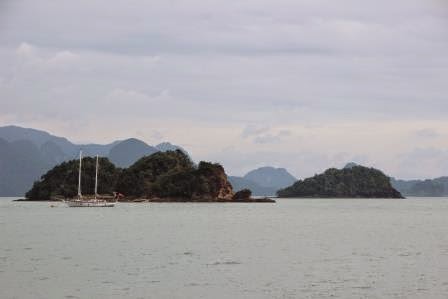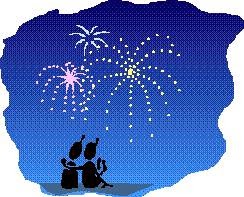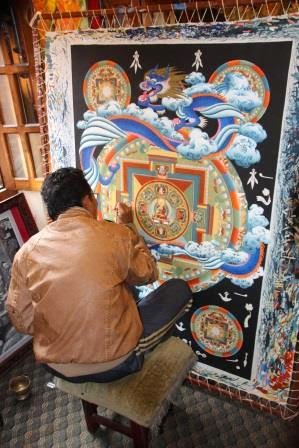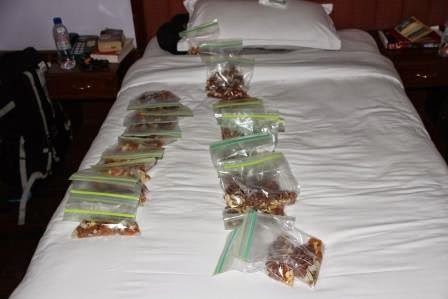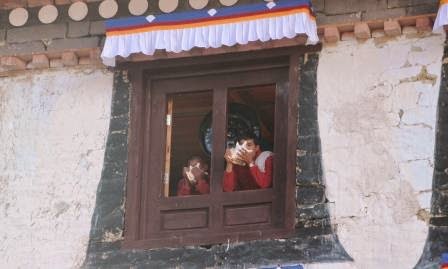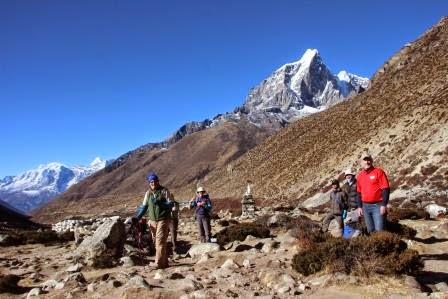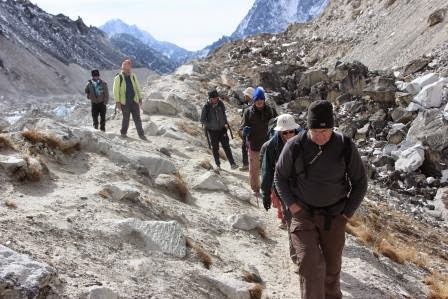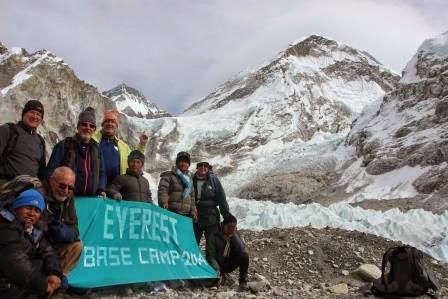• Dec 1 Arrived late in Kathmandu but none the less were greeted with garlands of Calendula by Kule and Narendra at the airport.
They must have been waiting a long time as it took the usual long queues to clear immigration and visa application and then we had a long, long wait for our baggage to arrive on the belt. Thank goodness there were only four of us; Peter, Eric and I and we joined up with Bob in KL. On that second leg we were able to sit in the exit row so enjoyed the extra leg room. Arriving at Potala Guest House we found it all quiet and appeared locked but then someone emerged to greet us and in the lobby we were warmly welcomed by the duty staff while others remained sleeping under huge quilts on the lounges. Our beds were warm and cozy, local time about 12.30am but for us it was more like 2.30 am Sg time.
• Dec 2 After breakfast we were met by Kule and Narendra along with the ever smiling Nava Raj. Nava Raj calls himself our son, having taken great care of us the last 2 years. Unfortunately, since our group is so much smaller this time he will not be joining us. He presented me with a very special gift; a traditional Sherpa woman's felt hat.
Kathmandu is such a colourful place! On the streets your senses are assaulted with colour, noise and smell.
Today we walked to the Hanumandhoka Durbar Square which is the original regional royal palace dating back to the 16th Century and the Malla Kings. It gets its name from the stone image of Hanuman, the Hindu monkey god, that sits near the main palace entryway and the whole 5 acre area is now a world heritage site. The royal family lived here until 1886, when they shifted to the most recent site, Narayanhity Palace. That palace was the scene of the 2001 Nepalese Royal Massacre and after the 2006 revolution toppled the monarchy, the newly elected assembly declared Nepal a republic and ordered the then king Gyanendra Bir Bikram Shah Dev to vacate the palace which is now a museum.
The standing statue of Hanuman (monkey god), dated to 1672, guards the palace. Hanuman is decked with a red cloth and an umbrella. The face is smeared with a red paste. Our boys are not cultural guides so they engaged one who explained all the different structures, temples and cultural practices.
A stone sculpture dated 1673 of Lord Narasimha (the half-man, half-lion incarnation of Lord Vishnu), devouring the demon Hiranyakashipu
This is typical Newari style architecture, developed in the Kathmandu Valley, marked by striking brick work and a unique style of wood carving rarely seen outside of Nepal.
These ancient buildings need to be maintained with the support of UNESCO funds.
But some critters just enjoy undoing all the good work.
The Kumari living goddess lives in this building onsite. She is chosen when about 4 years old and leaves her family to live here, she is retired when she first menstruates. We had the opportunity to view her today as our guide knew exactly where to be at the appointed time in the courtyard below these windows. She was heavily made-up and didn't look at all pleased to be there but apparently we have now been blessed with good luck.
The kumari is worshipped as the manifestation of the divine female energy, or devi, in Hindu religious traditions. No photographs are permitted and as one tourist drew out her camera our visit was instantly over. She can only be photographed on festival days. This is an image from Google.
We returned on foot to Potala and then took taxis to Hastaman's house. He is Narendra's brother and lives in Kathmandu. We were served an enormous meal cooked by Sam who trekked with us last year. Everyone made us very welcome and we shared the meal with a number of men who together form the Gudel School Board. After lunch Nava Raj returned with us to Potala where we promptly fell into bed for a siesta and Peter and Bob sat through a long meeting.
We joined Peter for a simple dinner of soup and momos at Bon Appetit on the rooftop beside the Curry House then had an early night.
• Dec 3 We were met after breakfast at 8am to drive out to Bhaktapur, now considered the cultural capital of Nepal, about 20 kms east of the city centre. It's history dates back to the 8th century when it was the capital of the region, Nepal was at that time many different kingdoms, the Kathmandu Valley was home to three. Bhaktapur has the best preserved palace courtyards and old city center in Nepal, and is listed as a World Heritage Site by UNESCO for its rich culture, temples, and wood, metal and stone artworks. The Durbar Square here is similar in many ways to what we saw yesterday with structures in the royal palace, temples and surrounds a mix of Southern Indian, Nepalese Newari and Buddhist architecture. Also included in a walk through the squares and township you find traditional water tanks, public shelters, massive brass bells, ornate gateways and private houses. The big difference here is traffic is banned in the heritage area so it is quiet and pedestrian compared to Kathmandu.

The Golden Gate is said to be the most beautiful and richly moulded specimen of its kind in the entire world.
Shiva Kedarnath Temple at left and Pashupatinath Temple on right. Contrasting architectural styles in Durbar Square, Bhaktapur. The structures supporting the roof of the Pashupatinath Temple, dedicated to Shiva, are embellished with wildly erotic carvings.
The Palace of Fifty-five Windows was built in 1427 AD and was remodeled in the 17th century. Among the brick walls is a balcony of fifty-five windows, considered to be a unique masterpiece of woodcarving.
The Naga Pokhari (Snake Pond) in the Palace of 55 Windows is a 17C royal water tank encircled by a writhing stone cobra.
Silu Mahadev, an oddity built after an earthquake. The large, white Fasi Dega Temple is dedicated to Shiva. Built on a six stage plinth with elephant guardians at the bottom steps, lions and bulls above them. The bull is Shiva's vehicle.
The carved wooden peacock window of the Pujari Math (monastery) building
The all-wood Chyasin Mandap pavilion (pavillion of 8 corners) is a showpiece.
In pottery square our guide showed how the potters still use the traditional methods of purifying the clay, modelling it on hand driven wooden wheels and fire it in a communal kiln.
With much effort he got it going at the correct speed then invited me to have a go but ........
I couldn't have even bent my knees enough to work on this wheel.
Walking downtown we were taken into a Thanka School of Artists who are devoted to becoming experts in producing Buddhist Mandalas, Wheel of Life or Buddha Life Story paintings. It was so interesting to have the paintings explained to us.
Returning to Kathmandu we had lunch and then met up with Jim who had just arrived after a terribly long flight originating in Port Macquarie.
It was time to get organised; we hired or purchased our sleeping bags, down jackets, poles etc then sorted the scroggin bags and re packed our bags.
I bought a new pair of shoes which would not be recommended the day before leaving on a trek but I just got concerned about the grip on mine. We said farewell to Nava Raj which was very sad. He has trekked with us these last two years and we have shared a special relationship. It would seem we will not be seeing him again.
Dinner was at the Yak Restaurant on the corner close to home then we arranged to leave some luggage at the guesthouse for our return. It was an early night as we leave for the airport at 4:30 am.
• Dec 4 We arrived at the airport in plenty of time, in fact we found ourselves locked out and had to wait in the early morning chilly dark for half an hour.
As expected our 6:30 flight to Lukla was delayed until 9am. In all Peter's treks the first flights have never left on time, but since the guides book him on the earliest flight at least he gets on the first ones that do take off once the fog lifts. The flight was stunning, we took many pictures but nothing will compare to seeing it with your own eye.
Lukla (2840 m) is renowned for an airstrip only one tenth of the standard length, at 460m it has a drop-off of over 3000m at one end and a solid stone wall at the other. You land on an uphill strip and hope to pull up before that wall. We watched as a number of planes taxied down the runway and took off downhill then over that drop. We get to do that on the way back. Awesome!
Lukla is a colourful township with many trekkers taking advantage of a late breakfast, as we did at the Sunrise Guesthouse where we will stay overnight on the return trip. We met our cook Parbat and porters Ocean, Bebe and Himal who have taken two days to walk in from Gudel. All of them did the job for us last year too.
The boys begin the job of assigning the weight in each pack to each porter
 Some are looking forward to the return visit already
Some are looking forward to the return visit already
Before leaving town we had to check in with the tourist police, which we will do a number of times in the days ahead. they check trekking permits and also list all the technology you have with you (cameras, tablets etc) so that they can pinpoint events and suspects should something happen.
We're already higher than Mt Kosciuzcko (2,228 m)! The familiar sound of mule trains was joined by jopkay trains today. These are yaks crossed with cows, bred as beasts of burden because yaks cannot handle going below an altitude of 2000m. We are seeing all the bulls (infertile), the females are called chouris and they are kept for milk and butter. There are some of these in Gudel apparently.
We walked in beautiful warm sunshine to Thadakoshi (2,600m) where we had a late lunch at the Windhorse Restaurant and Bakery Cafe in shirt sleeves.

autumn sunshine persists

Local schoolgirls

Tibetan Buddhist manu-rocks

more inscriptions

across ravines

Thadakoshi
It was only another hour on to Phakding (2610m) over Nepali Flat (little bit up, little bit down) where we made ourselves comfortable in the Shangri La.
We have followed a beautiful valley, the Dudhkhosi River at its basin has its source at the Everest Base Camp. Assembling at 3.30pm Jim presented all our intrepid porters with NAB hats and pens he collected in Australia and started the ball rolling for tomorrow's competition. The winner has to guess the number of people we pass carrying heavy loads. The funny thing was, the boys hats have a red star on them, same as the communists!
Today we estimated the heaviest would have been the men each carrying 6 sheets of 7-ply plywood which would be approximately 100 kg per load, apart from being incredibly awkward. Second was perhaps the man with a load of 9 cartons of beer.
Bob won the 'Silly Man Award scarf' for missing his flight from Sydney having to arrange another flight 24hrs later. These awards and competitions continued everyday of the trek and it was never hard to find a winner. After a hot drink we caught up with diary writing and Peter and I played ukulele. We were in bed early with hot water bottles, thermals, a blanket ....... And in no time I was sweltering and had to strip most of it off. I would have expected someone to warm the toilet seat at a Shangri La.
• Dec 5 We were on the track by 7:45am. The day started with Nepali Flat to lunchtime, which was at 11am since the Bishal Restaurant is the last tea house before the long, slow climb to Namche Bazaar (3,480m).

Jobkay cross the river

then we squeeze in

before the mule train arrives
Already today we have seen a man carrying 12 cartons of beer. Once again the sun is shining and the skies are clear. A beautiful day but get into the shadows and it is chilly. Makes it difficult to decide what to wear. Kule and Narendra and the others are constantly chatting with porters on the track.
It turns our many Rai lads from Gudel work here as porters, and the girls find work in the tea houses and collecting firewood etc. It's not far from home Kule tells me; 2 days quick-walk from home to Lukla.
Somewhere back there we crossed into Sagamartha National Park where there was a 3D model of the park. OMG, it looks long and hardI

Lunchtime
The afternoon walk was tough, we'd been warned that it was going to be our hardest challenge and I don't mind admitting I was tired at the end. Jim wore too many clothes and suffered heat exhaustion on the way up.

It was just relentless
At one point we took an extra 10 steps off the path to see the top of Everest, it was a magnificent sight and then just a little higher we saw both Everest and Lhotse (the fourth tallest peak in the world). Some people call the Himalaya Region the Earth's 'third pole' because its ice fields contain the largest reserve of fresh water outside the polar regions. I managed to do the walk without stumbling and tripping but seeing the outskirts of Namche Bazaar was very welcoming. Eric did it easier than me.
Just before reaching the township we were thrilled to see two pairs of Himalayan Monal, the national bird of Nepal. Their colours are amazing in the sunlight.
We were happy with our facilities at Hotel Norling where once again there is a pedestal toilet and we have the second floor to ourselves. The town, capital of the Sherpas, seems to form an ampitheatre nestled below some glorious peaks and looking across from our rooms we can see them setting up for the market which is held on a Saturday.
Tomorrow we are heading up to Khumjung then Khunde in the morning, about 400m higher, then returning here to acclimatize and have a second night at Hotel Norling. If I feel energetic enough I will visit the market after that. Another early night, it has been a very big day.
• Dec 6 Namche Bazaar - acclimatization day. We didn't sleep as well as we'd expected after all that exertion yesterday; Eric has a cold starting and I had a headache overnight. I have begun the herbal high altitude tablets. Eric has decided instead to take Diamox, the popular drug used in the treatment of mountain sickness. After breakfast we set off for the twin green villages of Khumjung and Khunde at an altitude of 3,800m, situated in a beautiful valley in the lap of the Khumbi Yul-Lha (Khumbu-country God).
To get there you first have to clamber up a ridge and that gave us a great view of the active market site.

After climbing

attaining the top of the ridge
Then you cross the airstrip which lies on the plateau at the top.
Apparently this was originally planned as the main airstrip for the region but the altitude is too high so instead it was established down at Lukla. Goods too difficult to carry in on mule trains or on the backs of humans are flown here in small charter planes or choppers and then from the weekly market are distributed to the villages.
In the heavens we also found this immature Himalayan Griffon.
The spectacular peak of Ama Dablam (6848m) on the right, which we will continue to see for the next few days. Nothing near the size of Everest or Lhotse (both over 8000m) but impressively beautiful especially with that background sky. It wasn't hard to pick out our continuing trail.
We kept going up to Hotel Everest View above the ridge at 3,380m where we sat on the balcony in glorious sunshine with panoramic views of the mountaintops. The valley below is surrounded on three sides by mountains and has magnificent views of Ama Dablam, Thamserku and Kongde-Ri. From a ridge above Khunde we saw Mt Everest again. The valley is the homeland of much traditional Sherpa culture.
Every field is surrounded by a metre high stone fence and every roof except for the school and hospital is painted green. This is fine potato growing country but at present the fields are fallow for winter.
At Khumjung we visited the Hillary Secondary School (founded in 1961) but unfortunately there were no students as it is Saturday. We enjoyed lunch in a tea house and then made our way to Khunde where there is an extensive hospital. The whole place is very quiet as most people have gone to the Namche Bazaar market.
Even those that attend the monastery are not on hand so we were unable to see what is believed to be the remains of a yeti. The locals certainly believe it to be true, it is connected with the spirit of the Khumbu-country God.
On the way home we were able to see our first glimpse of yaks (calves) at the Royal Yak Farm.
We made our way back to Namche, passing many people on their way home to the valley with goods, arriving about 3:30 in the afternoon. Several porters were seen using these shoulder poles instead of the more common doko baskets in this valley.
Back at Namche the market had packed up and I was just happy to have a sponge bath and rest anyway. Eric, Peter and Bob wandered downtown for about an hour. We are now trying to include some local Sherpa terms in our language. It's no longer 'Namaste' for hello, but instead tashi delek (darshy delay) and 'thank you' which was dhanyabad is now thuche (too cha)
•Dec 7 This morning Jim reported having had a very bad night with diarrhea, which follows a day of very poor appetite and heavy legs so it seems he has picked up a bug, or maybe it is the aftermath of that heat exhaustion; too early yet for altitude sickness. He struggled to join us on the walk to Tengboche Monastery (3,860m) today.
Leaving town we stopped off at the Sherpa Saga Sanctuary and Sherpa Culture Museum on the outskirts. We found it very interesting. Hillary met a man here who was deaf and suggested he run a museum and then helped arrange funding and this man and his family continue to run both the museum and an orphanage.
There was a traditional Sherpa home with all the artefacts and then a gallery of traditional Sherpa culture and another dedicated to the Sherpas who get the mountaineers to the summit.
Along the way we have walked by many rounded stones with Tibetan symbols covering them. I now understand they are Bhuddist mantras carved into the rock in clockwise direction and usually painted black and white but sometimes more colourful.
From there we walked around the ridge and found a family of Himalayan Monal right on the track. Once again we are walking in beautiful sunshine so the colours on the male were fabulous.
We met many yak trains this morning and people carrying astonishing loads of wood to be used as fuel. This is the time of year that collecting wood is permitted.
We had a long downhill walk into the valley and across a suspension bridge to lunch by the riverside at Fungkitenga. Can you see the bridge in this image?
From there we could see the trail goes steeply up and then continues up, up, up but at a more gentle rate to the monastery.
After lunch we tackled the switch-back trail up and up. It was tough and we were all glad when it evened out somewhat for the last hour. Hot and sweaty from that afternoon walk, we were soon chilled once you sat in the shade. And as the sun dropped so did the temperature.
Spotted our first Nepalese Tahr (mountain goat) today.

Kule with Ama Dablam as the backdrop
For the first time we are wearing gloves. Even indoors, where the dining room is unfortunately cavernous instead of cosy. It is chilly.
After settling in to the Tashi Delek Guesthouse we visited the Tengboche monastery.

Parbat at the prayer wheel
We arrived just as the conch shells were calling the monks in for a session which we were invited to view for a few mins. They chanted, rang bells, drank from special vessels, blew on horns and beat a huge drum. The room was very ornately decorated, there wasn't a spare piece of wall or ceiling left to paint with images or mandalas.
One trekking group heading down arrived with a woman so ill with a chest infection she had to be put on oxygen. She was choppered out in the morning. Returning to our room we were able to view a beautiful sunset over Everest. How blessed we are. After dinner we were in bed by 7pm. That was the warmest place to be.
• Dec 8 The trek to Dingboche (4,350m) will take us up another 500m. We were roused by a rhythmic drum beat just before 7am so have had a good recovery sleep. It looked to be another glorious day with the light setting off the peaks in turn against the blue sky early but it had clouded over by the time we hit the track at 8am. The good news is that Jim feels better this morning; had an uninterrupted 12 hrs sleep and ate breakfast.
We started off through a rhododendron forest, in gloves for the first time.
No wonder it felt cold, see the ice?
Within an hour they were off.
We walked down to a river crossing and saw the bridge that fell during construction last summer, the result of a landslide, so we had to keep going down lower to a temporary one. You can see the fallen one in the background here. Whenever we go down we know we pay the price.
Then the path began gently up.
We have seen a number of huge mountain goats this morning, more yak and in Pengboche, where we had a morning cup of kola chia, some nak (the females) . The most stunning thing though was I stopped to look for what made a cracking sound above me, perhaps a woman cutting timber, a musk deer or a goat but no, it was a rock hurtling towards me. I moved as quickly forward as I could but luckily Narendra was behind me and he gave me an extra shove so that it flew by just behind us, crossing the path about hip height and hurtling down the hill to the river. I'm very lucky it didn't take me with it. I now know not to stop and look for the source of the noise. Narendra thinks it was probably dislodged by a goat or a yak.

We followed the valley to Somare (4040m) a small village on the river flats where they grow buckwheat, potatoes and barley in very neat fields. We initially sat in the sunshine for lunch but moved indoors out of the wind, which is coming straight off the ice caps, at Sonam Restaurant. It was here I realised my knees had at last stopped shaking from that earlier near miss. The hillsides on either side of the valley are riddled with tiny tracks made by goats, yak and human wood collectors. Soon after the river split and we followed the Chhukung River, slowly making our way up to Dingboche. This is higher (about 100m) than we have ever been before, even Annapurna. The group is very quiet, no breath to spare for talking as we progressed up. Every little incline is 'Bistarai, Bistarai' slowly, slowly.
Approaching Dingboche
A solar power water heater
We are staying at the Sonam Friendship Lodge which is cosy, the walls of our rooms lined with green carpet - even the toilet seat is green carpet. Warmer than the Shangri La. But the shower is a shocker! Typically, this is where I chose to have one. Forget that idea for the next few days, I'll wait until I get lower and it is warmer for the next one. Back to pommy washes.
Another group of 2 have arrived, they are from Singapore of all places. When they lit the fire in the dining room the fuel they used was yak dung which we have seen drying on the top of stone fences as we have climbed. We are now above the tree line. So far we have had indoor pedestal toilets all the way except for the tea houses where we stop along the way.
This is an example of one with a pile of leaves to use for composting and a pile of dried dung behind for burning.
• Dec 9 the wind blowing the iron around on our roof overnight was disconcerting. Today we took a trip up the Chhukung valley (4,710m) for lunch and then returned to Dingboche as a second acclimatization day. Once again the sky is clear but the wind strong.
Fortunately for us it was at our backs the whole way up. We walked in just a thermal shirt and t-shirt.
The valley is surrounded by ice capped mountains which all provide water as the ice melts, Chhukung means 'surrounded by water'. We passed by yak roaming loose and saw a few birds too; it's a beautiful valley.

Red-billed Chough

Robin Accentor
We had lunch after a 2 and half hours gentle climb to Chhukung Valley Resort, one of the few establishments this far along the river.
We met people there who had given up on their attempts to climb Island Peak, the wind was just too strong and the forecast is that it will remain for the next few days. It would require walking along this ridge.
Another family from Cairns were all unwell and just hoping to get back to Dingboche today too, if their legs can carry them.
We headed out into the wind, blowing straight into our faces and brisk but not too uncomfortable buried under scarves. We scuttled down in just over an hour then enjoyed the sunshine streaming in through the windows of the lodge dining room. Having done this walk today we should be able to manage the one tomorrow without too much trouble, it's only 200m higher.
• Dec 10 Our trek today took us to Lobuche (4,920m).
We climbed up and over into the Khumbu Valley again, a tough start but then easy walking through what are the summer grazing fields for the yak.
We came across a number of corrals which the shepherds use to herd them into at night. Mostly so they don't wander too far but snow leopards have been known to come down this far and attack.
It was a steady climb to Thukla (4620m) in the sunshine but with a chilly wind, luckily at our backs. Everywhere we look we see fabulous snow capped mountains, very steep. Eric still has a lousy cold and I took far too many trips to that green carpeted throne last night. Today I am just sticking to dry toast and garlic soup until I am sure the diarrhea tablets have kicked in.
The climb out of Thukla was tougher than the morning start. The track zig zagged up the rise and it was just 'one foot in front of the other' with lots of stops.
At the top we found many stone memorials built to honour those who have lost their lives attempting the ultimate peak.
That climb took us up off the valley floor and we then followed a very rocky path to Loboche where we checked into the Hotel Peak 15. Just in case anyone thought that wasn't high enough after a cup of kola chia we walked up a nearby rise to look over the Khumbu glacier and the direction of base camp and Kalapattar. This took us up over the 5000m mark. It was slow, both going up and coming back down.
Thankfully the medication has done the trick so I ordered garlic soup and pasta for dinner.
• Dec 11 So this is how hard it is at this elevation. This morning I was stuffing my sleeping bag into its bag and just pulling tight the last strap to compress it when suddenly it came undone and sprang back out like a jack in the box. I had to take 10 deep breaths before I could even swear profusely, and then I started all over again. It took another 10 deep breaths before I could do up my shoes. We had been woken at 5am with hot milk coffee so that we could be on the track to Gorak Shep by 6am.
We started in the dark with headlamps but it wasn't long before they could be turned off. It was quite a bit longer before we saw the sun crest the mountains and by then we were well on our way and getting a little warmer. It was so cold out that Jim's water supply froze in the tube of his camel pack.
It began as Nepali Flat then climbing, we followed the Khumbu River as it became glacial. There was a massed accumulation of boulders, stones, and other debris carried and deposited by the glacier on either side and strewn across the top. This is called the moraine and makes it quite moonscape like.
We arrived at Gorak Shep just before 9am and had an early lunch before heading up to Everest Base Camp (5,300m). In this image of Gorak Shep above you can see the path up to Kalapatar which we will take, if we are up to it, tomorrow morning. Thats just the hill in the foreground, not the mountain behind.
What surprised us the most was the flock of Tibetan Snowcocks who make themselves at home around the camp.
It wasn't long before we could see the pristine Khumbu Glacier as it sweeps down from Everest, takes a 90 deg turn and then heads down the valley.
The walk was tough and if anyone had told me the current site of Base Camp was out on the ice I probably would have told them I wasn't interested.
I found it frightening to step onto loose stones that are buried in the top of solid ice. When they slip chances are so does your foot onto the ice and then you're in big trouble.
We all made it out to the Base Camp, leaving at about 10am, took the photos and returned to Gorak Shep about 2pm. Jim was especially taken by the presence of a cricket bat commemorating Phillip Hughes, Aust cricketer who died in Nov.
I don't mind telling you I can't remember ever being so tired when I returned to the lodge. Completely spent. We had a hot tea and some Nepali 2-min noodles then rested up. Eric is really struggling with a cold so will sleep-in tomorrow morning. It is so, so hard to get warm even indoors. We are wearing every layer (2 pair thermal long johns and 3 tops, puffer jackets and slippers). We look like the Michelin Man. Another early night.
• Dec 12 Four of the five of us rose at 5:45am for a 6am attempt on Kalapattar (5,545m), a mountain right beside the guesthouse. I was never sure I was going to tackle the peak but I wanted to get to the halfway point.
We haven't really seen much of Everest except it's tiny summit to this point, not even from the Base Camp. At the halfway point we had a really good view of Mt Everest and the Khumbu Glacier that originates on her.That black peak behind Bob is what all the fuss is about. It is quite easy to identify because it has no snow on this face, too steep and the wind up there blows it all off.

The top of the glacier reminds me of piped icing, hundreds of peaks and crevasses which have to be crossed by the climbing teams. To do this the Sherpas erect ladders across the crevasses and it was while they were fastening these in place this year that an avalanche disasterously occurred. The glacier does a left hand elbow turn at the base then continues down the valley. It is just off this elbow that the summer Base Camp is located, a flat stony area. It is hard to believe that up to 600 people might be camped there (the climbing teams and their support teams) in the short window of opportunity the weather provides when the winds are less than 100 km hr at the summit. At the halfway point Jim felt he should save himself for the rest of the day's trek and he and Peter went back down. I was feeling fine so decided to continue up even though the view you get from halfway is really as good as it gets. I just wanted to attempt the challenge. It got harder and harder, we had to stop more often for breathing breaks the higher we got, but Bob and I made it to the top.

The last 100m there is no track, it is just a rock scramble and I am happy to admit that Parbat and Kule literally dragged me over it. It had taken us just on 2 hours to get to the summit. There is a weather station there.
Getting down was the next challenge with my dodgy knees and it took us almost as long.
Almost down. Everyone else was packed and ready to start the day's trek so we had a quick breakfast and threw everything into our bags and joined them. It is all downhill from here, we are on our way home.
You don't expect to find birds in such a desolate place, hardly anything grows here, but the Gret Rosefinch is in abundance.
And the day's walk was all downhill to Thukla for lunch where the boys enjoyed their first Everest beer, and then down, down to Pheriche (4,240m). We have stuck by the rules of no alcohol on the way up, too dehydrating in these conditions.
That's 900m down from Gorak Shep but for Bob and I, more like 1300m.
The last section through the valley we had to cross many small, icy streams that can be treacherous and once again it was thanks to my 2 guardian angels Parbat and Kule who safely got me across and kept me in touch with the group ahead. It had been a long day but we finished at the welcoming Mt Pheriche Guesthouse with a warm dining room. Only disappointment was it doesn't have a pedestal toilet (first place we've stayed without one) and after all that downhill I really could have done with one. My knees are complaining. Our trek took 8 hours and then if you add the morning climb I did, it has been a long day. Straight to bed after dinner for me, the rest enjoyed a nip of Chivas Regal.
• Dec 13 As we assembled after breakfast for the presentation of the silly award we could look back at the heights from which we had come and see snow falling. It is overcast this morning for the first time but not threatening rain.
We followed the river for a short way then climbed the ridge and tackled the long climb up to Tengboche through the rhododendron forest once again.
A nak being milked by hand at Pangboche.
This was a long tough climb and probably a good thing it was overcast. Easier for us than these porters.
We enjoyed a cuppa in a tea house near the monastery and then walked down, down, down to the riverside for lunch. Jim was remembering what that last stretch was like in reverse the day he was feeling very unwell. It is all feeling so familiar, having done it in reverse a week ago.

Enjoying lunch in the sunshine was only spoilt by the fact that we knew we were facing a long, hard climb up to get to 3,480m, the height of Namche Bazaar. Once that was done though it was Nepali Flat to the end. Each time we rounded a corner I was hoping to see the outskirts of town. It was very rewarding to at last see the Sherpa Museum in the distance. Peter and Bob dropped in there to buy some photographs while the rest of us made our way to Hotel Norling. I headed straight for a shower while Eric and Jim enjoyed an Everest Beer. While we were waiting for dinner we heard 'London Thumakda' playing on the radio in the kitchen. That's the music to the dance we learnt and performed at the MAE Annual Dinner. It was another 8 hrs on the track, descending 800m, so once again I was falling asleep at the table after dinner and went to bed. The boys stayed up a little longer and there is one less 300ml whiskey bottle to carry tomorrow.
• Dec 14 Lying in bed this morning, suddenly a lightning bolt lit the room and thunder rolled. Doesn't auger well for a good day. Eric coughed a lot early in the night but then slept well so hopefully he has broken through the cold he has carried ever since we left here on the way up.
As light grew we discovered we were in a winter wonderland. It has been snowing for some time, there is 6" on the rooftops. There was I thinking of massages and eating all day but alas, Kule believed we just need to get down to the bridges and it will only be rain. Oh joy!
The forecast here is that snow will continue to fall until Tuesday. The temp is -3 deg. So off we went at 8:30am to trek to Phakding (2,610m).
It was powder to start with, then very fine as we headed though the pine forest. Biggest problem, since we were all warm and had gear to keep us dry, was the footing. It was very slippery in places. If I wasn't convinced earlier, my new shoe purchase in Kathmandu was vindicated today! Kule and Parbat looked after me but we saw a number of porters trying to carry heavy loads and negotiate the slippery corners with great difficulty. We all managed to keep our feet but for Bob, who lost it just for a second. My greatest motivation to stay on my feet was all the mud mixed with animal pooh. We didn't see any beasts of burden today, guessing it is too expensive if one of them slips and breaks a leg, not so the human porters apparently.

We stopped for a coffee at one point and the weather looked to get heavier before clearing enough to keep going. We had the best lunch yet at Monjo. Was the food that much better or was it that we were so pleased to be taking a break, being warm and being fed? No, everyone agreed the food was good.
We plugged on through pretty light rain, luckily no freezing wind with it, until we got to our destination of Phakding. The peaks certainly are beautiful with a dusting of snow.
You could call this the day of bridges; we have crossed 5 suspension bridges and the same number of static ones. It didn't occur to me on the way that there were so many, perhaps I was too busy taking in all the scenery where today I was terrified of slipping in the wet conditions and kept my eyes down.
Back at the Shangri La. Took some time to find enough nails to hang our wet trousers, hats and jackets on. Found the coffee shop and moved in on a group of Poms we have been crossing paths with and exchanging pleasantries (or was that sledging) over the last few days. On the kettle fireplace they have a selection of hot rocks we can put in our pockets and then rotate as they cool. Fantastic idea! And a cappuccino coffee machine with Lavazza Coffee. Opened a flask of Khukuri Rum to warm myself after that long wet walk.
• Dec 15 Today I was roused by the bells of a mule train, that's comforting. The weather outlook must be much better. Lifting the curtain I could see blue sky and the sun was just catching the top of the mountain in view. We heard about a number of trekkers caught on the wrong side of the Gokyo Pass which has been closed by snow. At least they are all in lodges as far as we know. Our trek to Lukla (2,795 m) was always going to be a short and comparatively easy one.
We had a later breakfast and hit the road; so nice to be walking in sunshine though quite chilly early in the shade. We constantly heard helicopters on a rescue mission to bring those trapped trekkers back down. We were intrigued to see the progress made on this house being built right beside the track. Every stone is hand chiseled and the finish is amazing. Such craftsmen.


We stopped at a lovely sunny spot for a cuppa. What a difference a day makes. From there we could watch the planes landing and taking off from Lukla airport. We had just a short uphill walk into town. Along the way today I think we have all been contemplating what this trek has meant to us. I thank Peter for making it all possible in the first place. I've met Bob who is a lovely fellow and I thank him especially for opting to go to the top of Kalapattar, if he hadn't I wouldn't have either. It was wonderful to do this with our dear friend Jim, you couldn't meet a nicer bloke. And then what would be the point of it all if I hadn't been able to do it with Eric. As for Narendra, I have put my life in his hands and he has turned up trumps again. Nothing is too much trouble for Kule and he does it all with a smile making sure of my safety too. Parbat has been beside me in every downhill stretch ensuring my safe delivery and that I don't get too far behind. Bebe, Ocean and Himal have carried our bags with great care and responsibility over some pretty difficult terrain and in some lousy conditions without fault. What a team we made.

The Sunrise Guesthouse provided us with a lovely sunny courtyard right on the street where we could enjoy a rest and watch all the action as we ate lunch and shared an Everest beer together. A lazy afternoon saw us drift to the Scottish Bar only to find there wasn't a scrap of tartan or a dark beer to be had.
Back at the Sunrise we assembled for a shared dinner of dahl baht with all the boys. They had each taken their share of our donated gear (headlamps, poles etc), and then we partied with some silly singing and dancing, including 'London Thumakda'. This looks a lot like Hokey pokey to me.
We finished by tipping each of our support party as is the tradition.
• Dec 16 We were roused for our 6 am breakfast ready to be at the airport in time for our flight to Kathmandu only to discover it was snowing, so no rush. We had been looking forward to sleeping between sheets instead of in sleeping bags but we'd had a dreadful night sleeping on a lumpy mattress with a dead drop heavy blanket.
The news that the airport was closed did nothing to cheer us. The dining room was dreary and cold as we waited and waited, hoping for a break in the weather.
Sam, who trekked with us last year arrived, he is meeting a group who hope to trek to Mera Peak from here if the weather permits. Parbat and Bebe are going along too. No rest for some. Eventually we had a coffee across the road and got the message that the airport was open so we needed to get our bags over there for check in. Everyone else in the town must have got the same message as it was on for young and old. At times like this you know you are in good hands. Narendra and Kule are treated as locals and the young girl who had been serving us at the guesthouse also arrived at the airport to make sure our group got priority service. In no time we were sitting in the departure lounge, fingers crossed. Of all things 'London Thumakda' began playing on the video hits tv program. Don't worry, we weren't inspired to get up and start dancing. All of a sudden the planes began arriving in quick succession. Tara Air was the third to arrive and did a very quick turn around at 11:30 with all of us onboard. No one was as relieved as Jim who had been worrying he would miss connecting flights if we had had to stay another night in Lukla. Take off was exciting to say the least, racing down the downhill runway and lifting off well clear of that enormous drop off I mentioned days ago. So it is all over. We checked in to the Potala Guesthouse once again, met for lunch in the Yak restaurant and then all went off to do our own thing. The boys in turn visited the hairdresser for a clip and massage, we had Christmas shopping to complete and hire items to return. We met up again for a last dinner at Northfield Cafe and Jesse James Bar. We spent a night here last year too and found the Beni Outlet that uses recycled products to raise money for social projects. We became their best customers buying copies of a book, bags and cards. And then we went home and cleaned up what was left of the alcohol.
• Dec 17 What a wonderful sleep. After breakfast together and a team photo in the EBC shirt we met Narendra and Kule who took Jim off to the airport and the rest of us did our own thing.
I was just happy to relax in the sunshine of the Potala Guesthouse courtyard. We all caught up for lunch on the 7th floor of Helena's, a nice change to be sitting on the open terrace in the sunshine here, Peter usually has us sitting out here for dinner and it is always freezing. Tiredness had overtaken us and we just whiled away the hours until dinner at the Roadhouse Restaurant where we enjoyed wood fired pizza before meeting Kule and Narendra who took us to the airport. They presented us with gifts not to be opened until Christmas and a traditional hat each. We departed Kathmandu just before midnight to arrive home in Singapore on Thursday 18th. After a sleep, Eric went to the Dr. and discovered he has bronchitis so now with some medication it should at last clear up.













